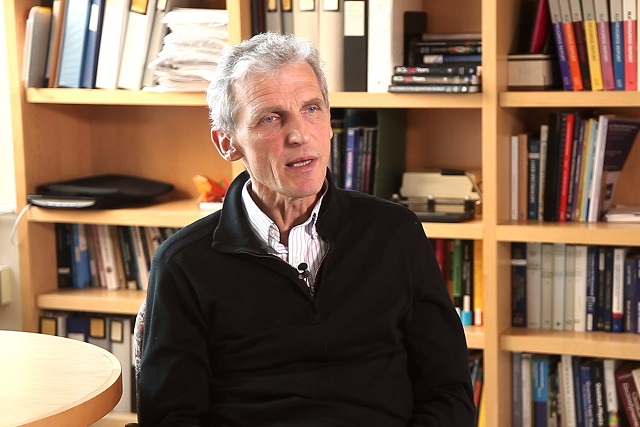DNA Breathing
Boston University Professor Maxim Frank-Kamenetskii on the double helix structure of DNA, formaldehyde reactivity, and the Hoogsteen pairing
videos | August 4, 2014
Is DNA affected by thermal fluctuations? What is the difference between the Watson-Crick pairing and the Hoogsteen pairing of nucleotides? Professor of Biomedical Engineering at Boston University Maxim Frank-Kamenetskii speaks on errors in nucleotide connections.
Obviously, one of the reasons why DNA is double helix, why it is so useful a structure from the viewpoint of nature is that bases are buried within the double helix, so they are really very poorly accessible for any damage which can be inflicted. And in principle, if you look at this structure, they are almost not accessible, very poorly accessible for outside agents. And there are,of course, many dangerous chemicals around and one chemical, which everybody knows about in this respect, is formaldehyde. Formaldehyde – people use formalin to fix all kinds of organs and so forth. So it is a very reactive substance.
And so this “DNA breathing” concept emerged, that is, DNA breathes and because this breathing may be very important to understand chemical reactivity of DNA and mutagenesis and cancerogenesis and so forth, and so forth. And so we studied this and we arrived at the conclusion after pretty complicated biophysical studies of this that this base pair opening really can happen and they can happen with very low probability, but still it explains essentially how formaldehyde reacts with DNA. And this probability, which we estimated (we actually were the first, who arrived at a right estimation of this probability of base pairs opening) it is 10^-5. So on average if you go along DNA on average every 100 000th base pair is opened. It’s a very, very rare event.
They discovered that in a normal double helix not every base pair is in the Watson- Crick pairing. So since Watson & Crick paper of 1953 we believed that all base pairs are Watson-Crick base pairs, but actually in early 1960s an x-ray crystallographer named Hoogsteen, he discovered just in crystals of bases, no relation to the real DNA, just studying crystals of DNA bases he found that another base pairing mode in principle is possible for a base pair, it is called ‘Hoogsteen pairing’ because of him. And if in the Watson-Crick pairing you can consider the base pair as kissing each other – just mouth to mouth – in the Hoogsteen pairing it is one base kisses the other base into the cheek.





























